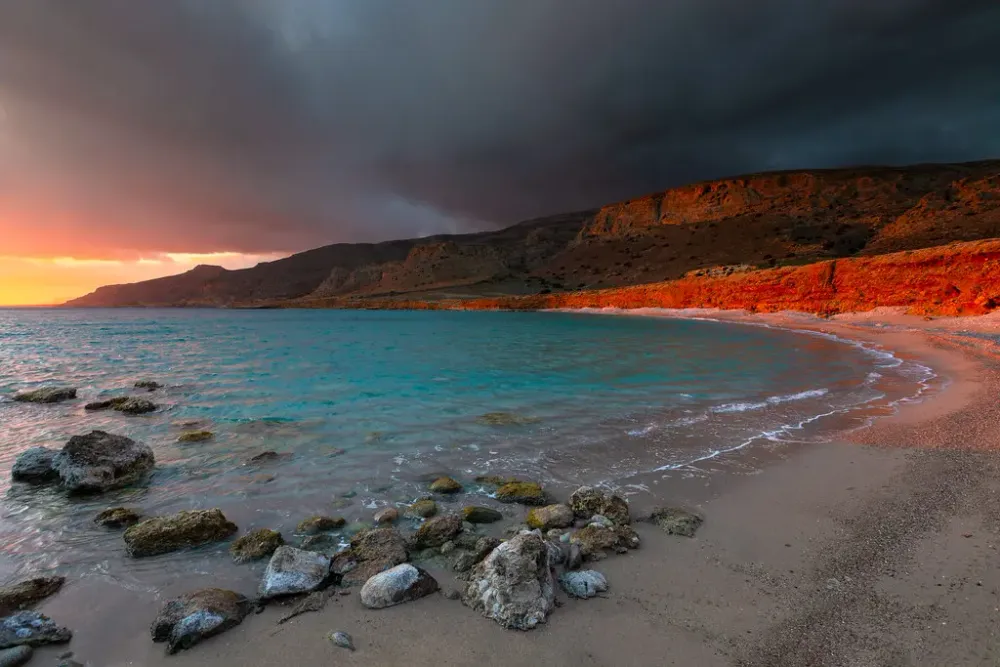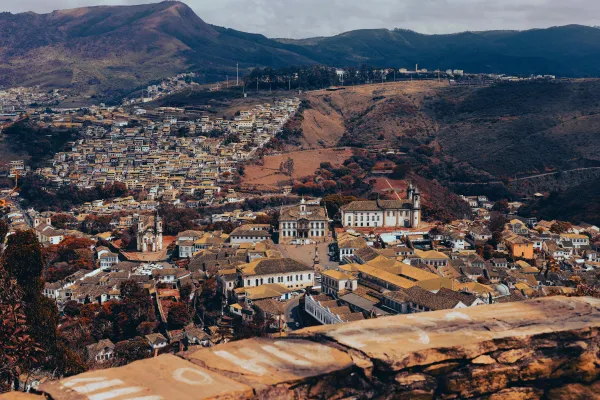Best Beaches in Crete That Blend Relaxation and Local Shopping
Crete, the largest of the Greek islands, has been a crossroads of civilizations for more than 5,000 years, and its beaches reflect that layered history. Long before modern travelers spread their towels on Elafonissi’s pink sands, the Minoans—Europe’s earliest advanced society—were sailing from these shores with amphorae of olive oil and painted ceramics. Later, Roman traders, Venetian merchants, and Ottoman caravans left their mark, turning Crete into a hub where the sea was both playground and marketplace. Many of today’s coastal towns still trace their layouts back to Venetian harbors, lined with arcades that once held spice stalls and cloth shops.
This fusion of leisure and commerce has endured. Crete’s beaches are not just stretches of sand but living gateways into local life: places where you can bask in the Aegean sun and then wander a few steps to discover leather workshops, olive oil cooperatives, or markets buzzing with herbs, honey, and woven textiles. From Chania’s old Venetian port to the palm-fringed coves of Vai, every beach carries echoes of the island’s past while offering modern comforts.
These are our favorite beaches in Crete.
1. Elafonissi Beach (Southwest Crete)
Best beach for colorful sand
Elafonissi, one of Crete’s most photographed beaches, owes its fame to the blush-colored sands created by crushed seashells and its lagoon-like shallows that stretch far into the Libyan Sea. Yet beyond its beauty, the site carries a weighty past. In antiquity, this corner of southwest Crete was a waypoint for Minoan and later Phoenician traders who hugged the coastline on their way toward Africa. Venetian sailors later marked Elafonissi on their maps as a sheltered anchorage, though the surrounding reefs made navigation perilous.
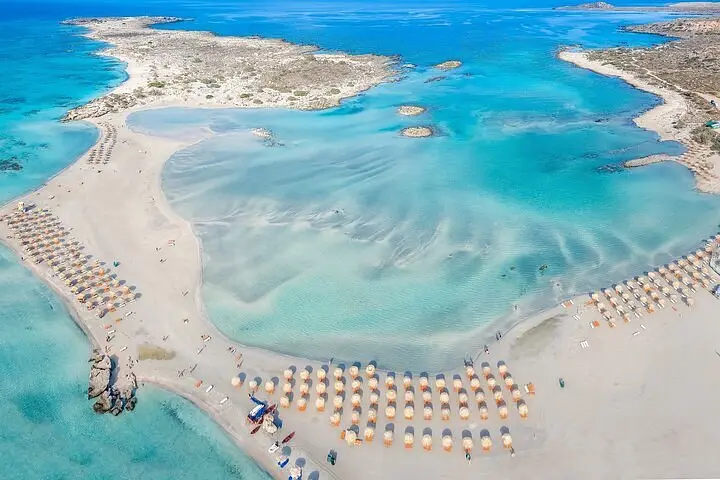
The beach is also remembered for tragedy: in 1824, during the Greek War of Independence, Ottoman forces massacred hundreds of locals who had sought refuge here. A small memorial at the nearby monastery of Chrysoskalitissa recalls this chapter, giving visitors a poignant glimpse into the island’s turbulent history.
Today, Elafonissi has transformed into a place of serenity, drawing families and day-trippers for its safe, shallow waters. Along the approach road and near the parking areas, small stalls and kiosks sell Cretan handicrafts, woven beachwear, and local snacks like thyme honey and paximadi rusks. The combination of a historically significant seascape with contemporary local commerce makes Elafonissi a destination where relaxation is layered with cultural discovery.
2. Balos Lagoon
Best beach for a castle adventure
Balos Lagoon is one of Crete’s most iconic natural wonders, celebrated for its turquoise shallows and the dramatic Gramvousa Peninsula backdrop. But beyond its postcard-perfect beauty, Balos has been strategically important for centuries. In ancient times, this stretch of coast was a natural lookout point for Minoan sailors navigating toward the Aegean. Later, during the Venetian period, the fortress on nearby Gramvousa Island was constructed in the 16th century to guard against Ottoman incursions and pirate raids. The ruins of the fort still stand, offering sweeping views that tie the lagoon’s tranquility to its defensive past.
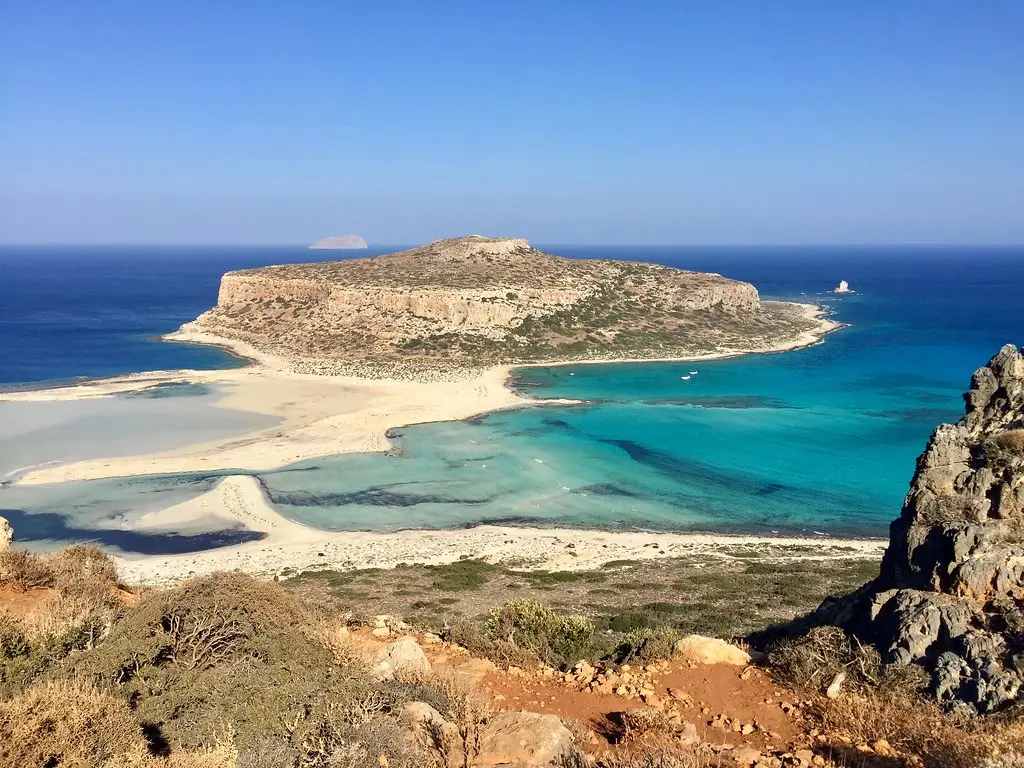
The lagoon itself became a hiding place for corsairs in the 17th and 18th centuries, and local legends tell of treasures buried on Gramvousa by Mediterranean pirates. Today, instead of warships, you’ll see small boats bringing day-trippers from Kissamos, retracing those old sea routes more peacefully.
Modern visitors come to float in Balos’ shallow waters and walk its sandbars, but the cultural experience continues off the beach. In Kissamos town, the nearby market and small vendors sell jars of Cretan thyme honey, olive oil pressed in local cooperatives, and hand-carved souvenirs — reminders that Crete’s history of trade still thrives along its shores.
3. Falassarna Beach (Western Crete)
Falassarna Beach, Crete, is not just a paradise of golden sand and crystal-clear water, but also a place steeped in history. In antiquity, Falassarna was home to one of the most important city-states of western Crete, a maritime power that flourished during the Hellenistic period. Archaeological remains of its harbor, quays, and fortifications can still be found a short walk inland, reminding visitors that this idyllic shoreline was once a bustling trade hub. The city minted its own coins and was notorious for piracy until it was destroyed by the Romans in 69 BCE.
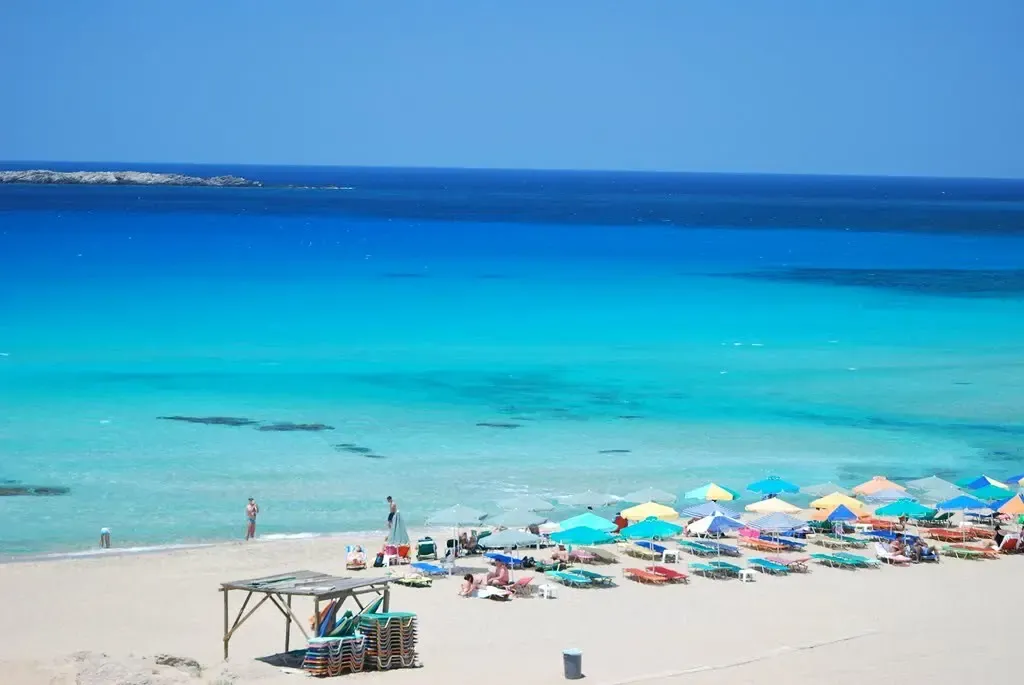
Today, the vast stretch of sand is divided into smaller coves, making it easy for travelers to find both lively areas with umbrellas and quiet corners for solitude. The area’s fertile plains also tie into its history — Falassarna remains a center of olive and produce cultivation, a continuation of agricultural traditions dating back thousands of years. Modern-day beachgoers can balance relaxation with shopping by visiting the local shops and mini-markets along the road to the coast, where olive oil, herbs, and handmade crafts preserve the spirit of Crete’s trade legacy. At Falassarna, the experience of sunbathing is interwoven with the echoes of an ancient harbor that once connected Crete to the wider Mediterranean world.
4. Vai Beach (Eastern Crete)
Best for combining sunbathing and exploring local shops and eateries
Vai Beach Crete is bordered by the largest natural palm forest in Europe, covering about 250,000 square meters with more than 5,000 Cretan date palms (Phoenix theophrasti). The species is endemic to Crete and was mentioned by the ancient Greek botanist Theophrastus in the 4th century BCE. Archaeological evidence indicates that the eastern coast near Vai was active during the Minoan period, with sites such as Itanos and Palaikastro showing extensive maritime trade networks connecting Crete with Egypt, Cyprus, and the Levant.
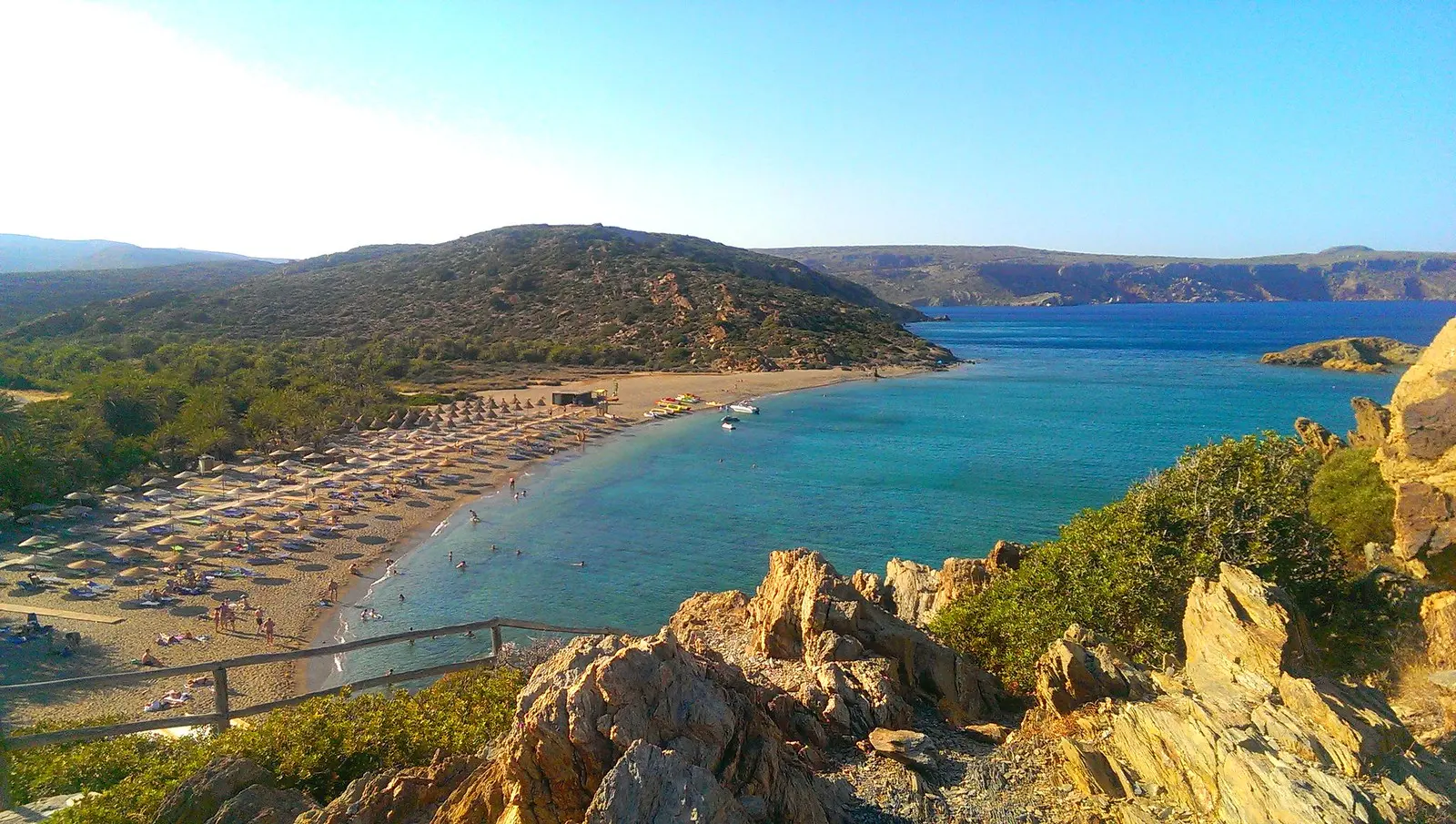
Excavations around nearby Itanos reveal temples dedicated to Athena and other deities, coins bearing inscriptions of the city-state, and traces of fortifications, highlighting the area’s significance as a commercial and religious hub from the 7th century BCE through the Roman period. The palm grove itself was long associated with myths of Phoenician or Arab sailors planting seeds, though botanical studies confirm its native origin, dating back thousands of years.
During the Byzantine and Venetian eras, the area around Vai remained sparsely inhabited but strategically important for controlling eastern maritime routes. Its isolation preserved both the palm grove and the traces of ancient coastal settlements, making Vai a rare site where natural history and archaeological record converge.
5. Agios Nikolaos – Kitroplatia Beach
Kitroplatia Beach lies in the center of Agios Nikolaos, a coastal town that has been inhabited since the Late Minoan period. Archaeological finds in the area, including chamber tombs and pottery, show that the region was active around 1500–1400 BCE. The name Kitroplatia refers to the citron (kitro) trees once cultivated nearby during Venetian and Ottoman times, when the town served as an agricultural and trading port.
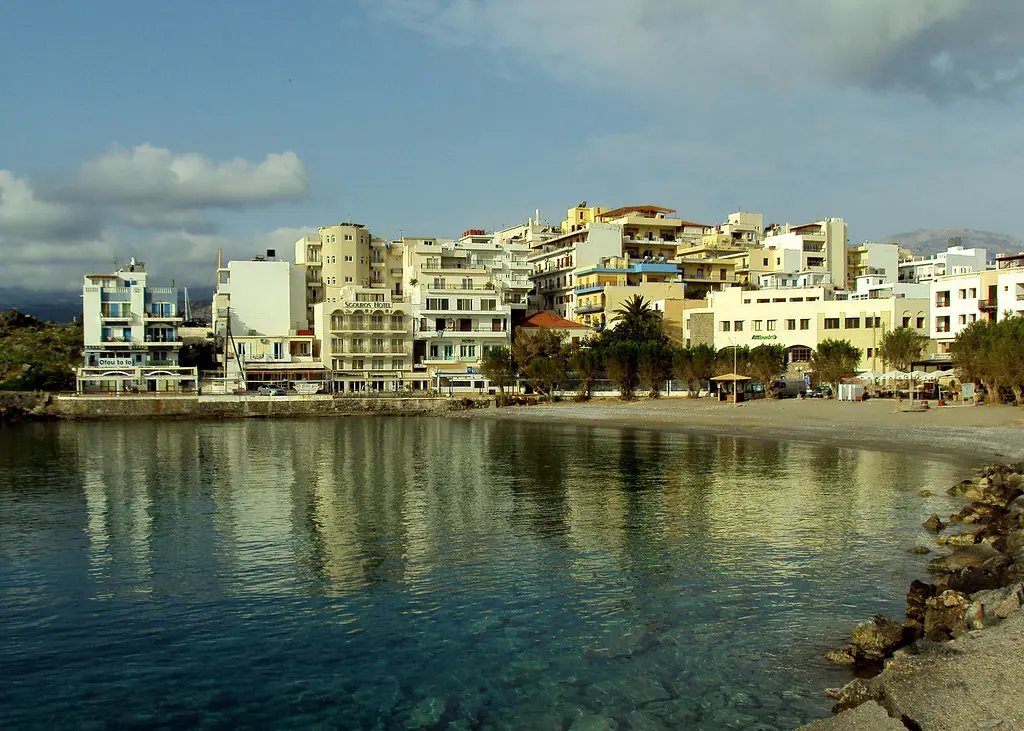
Agios Nikolaos itself is named after a 7th-century Byzantine chapel dedicated to Saint Nicholas, still standing on a small peninsula east of the modern harbor. The town grew during the Byzantine and Venetian periods due to its strategic location along the Gulf of Mirabello, Crete’s largest natural bay. Venetian records mention the gulf as a safe anchorage for ships moving between Candia (Heraklion) and Rhodes.
In the 19th century, under Ottoman rule, Agios Nikolaos was a modest fishing village, but its central position made it the administrative center of Lasithi after Crete’s union with Greece in 1913. Kitroplatia, with its proximity to the old port, reflects this layered past — from Minoan settlement to Byzantine chapel and Venetian harbor activity — compressed into a small but historically dense part of the town.
6. Chania – Nea Chora Beach
Nea Chora, meaning “New Town,” developed west of Chania’s Venetian harbor after the 17th century. The area lies just beyond the Venetian walls that once encircled Chania (then called La Canea), which the Venetians fortified in the 16th century to defend against Ottoman expansion. When the Ottomans captured Chania in 1645, settlement gradually spread outside the walls, giving rise to what became known as Nea Chora.
The beach itself sits on a shoreline that has been in use since antiquity. The nearby ancient city of Kydonia, one of Crete’s most powerful city-states, occupied the site of modern Chania from the Minoan period onward. Archaeological finds in the area include Linear A tablets, Minoan houses, and Roman mosaics, indicating continuous habitation.
During the late Ottoman period, Nea Chora became one of the first organized extensions of Chania outside the medieval fortifications, with fishermen’s houses and workshops lining the coast. By the late 19th century, it was known for its small shipyards and fish market, which served both locals and foreign merchants docking at the harbor.
Thus, Nea Chora Beach is not only a modern bathing spot but part of a continuum of settlement and maritime activity stretching from Minoan Kydonia through Venetian fortifications to Ottoman urban growth.
7. Rethymno Beach
Rethymno Beach stretches along the northern coast of Crete beside the town of Rethymno, a settlement with continuous habitation since antiquity. The ancient city of Rithymna, mentioned by the 4th-century BCE historian Claudius Aelianus, occupied this area and minted its own coins depicting maritime symbols, evidence of its role as a small harbor town. Archaeological excavations around the wider bay have uncovered Hellenistic remains, including fortifications and burial sites.
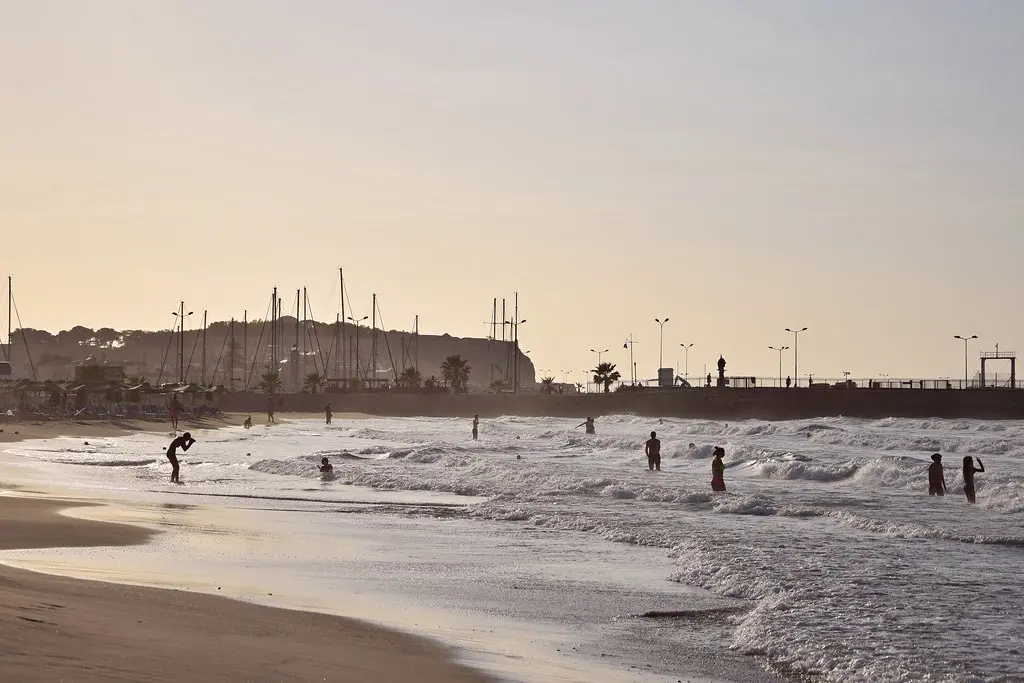
During the Venetian period (1205–1669), Rethymno expanded significantly, with the long sandy shoreline serving as a landing place for ships unable to enter the small enclosed harbor. Venetian records from the 16th century describe Rethymno as a secondary port between the larger hubs of Heraklion and Chania, important for grain storage and troop movements. The Fortezza, built in 1573 above the shoreline, was constructed in part to protect the coast and its anchorage from Ottoman raids.
After the Ottoman conquest in 1646, the beachfront remained an active zone for fishing and small-scale trade. By the 19th century, tavernas and workshops lined the coastal road, which connected Rethymno with Heraklion to the east. The beach, therefore, has long functioned as both a defensive frontier and a maritime corridor, linking the town’s Venetian core with the broader Mediterranean.
8. Elounda Beach
Elounda lies on the north coast of eastern Crete, facing the Gulf of Mirabello, an area of continuous settlement since Minoan times. Just offshore is the island of Spinalonga, originally a natural extension of the peninsula that was fortified by the Venetians in the late 16th century. The fortress was built between 1579 and 1586 to control access to Elounda’s harbor and safeguard Venetian trade routes in the eastern Mediterranean.
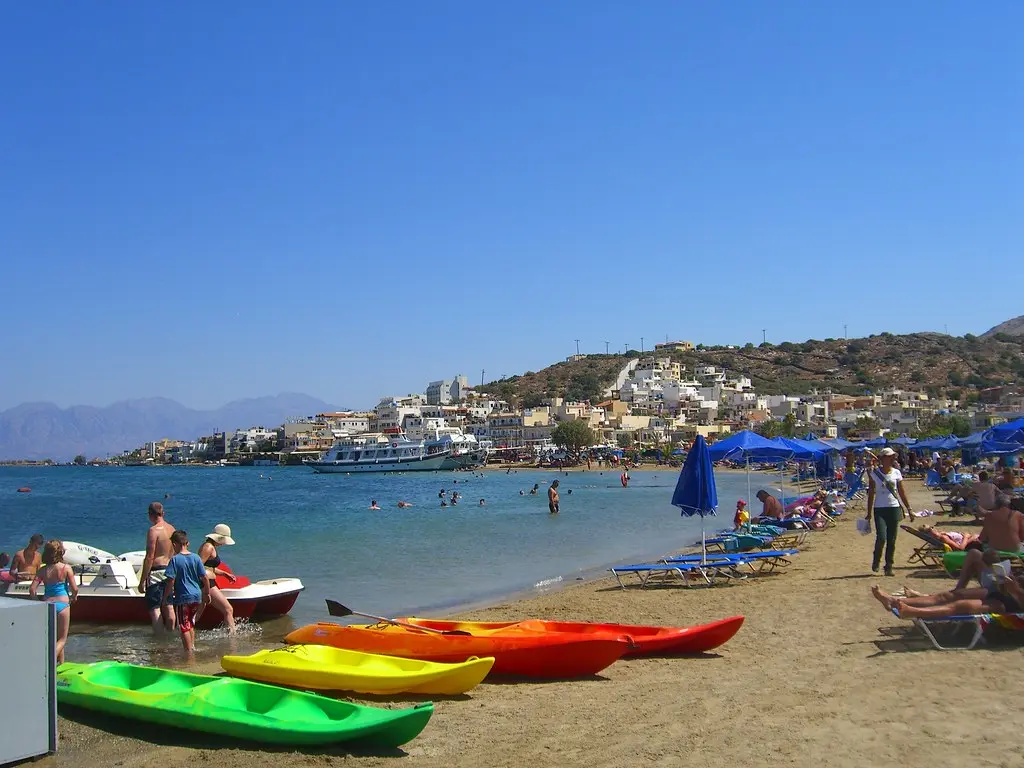
The bay itself had strategic importance long before the Venetians. Remains of the ancient city of Olous, one of Crete’s significant city-states during the Classical and Hellenistic periods, lie submerged near Elounda. Olous minted its own coins, some bearing images of Artemis and Zeus, evidence of its independence and economic role in maritime trade. Archaeological surveys have identified city walls, temples, and harbor installations now partly underwater due to geological shifts and gradual submersion.
During the Ottoman era, Spinalonga remained a fortified outpost, and in 1715 it became one of the last Venetian possessions to fall. Later, from 1903 to 1957, Spinalonga served as Greece’s leper colony, isolating patients on the island within sight of Elounda’s shore. Thus, Elounda Beach lies at the center of a landscape where ancient Olous, Venetian military architecture, and 20th-century medical history intersect.
9. Malia Beach
Malia Beach lies near one of the most important Minoan sites on Crete, the Palace of Malia, located about 3 kilometers inland. The palace, dating to around 1900 BCE, was the third-largest on the island after Knossos and Phaistos, covering nearly 7,500 square meters. Excavations led by Joseph Hadzidakis in 1915 and later by French archaeologists revealed storerooms for agricultural surplus, workshops, and a central court used for ceremonies. The palace was destroyed around 1450 BCE, likely during the widespread collapse of Minoan centers, but continued to be inhabited during the Mycenaean period.
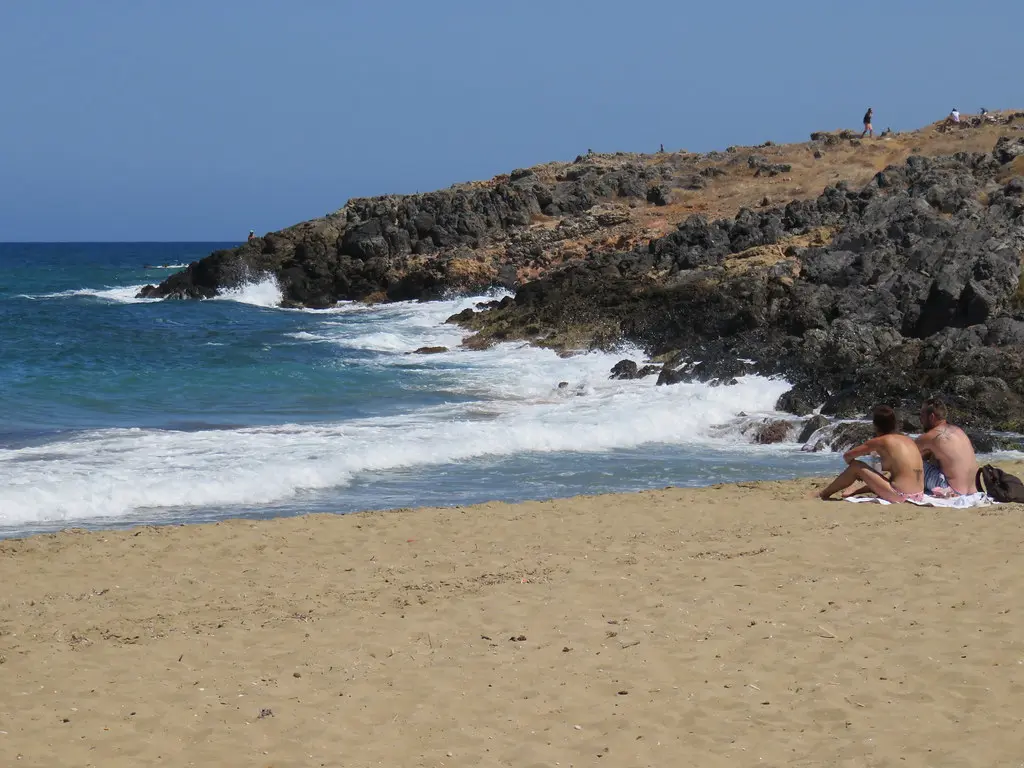
The coastal plain around Malia was fertile and heavily cultivated in antiquity, supplying the palace economy with olive oil, wine, and cereals. Archaeological remains of harbor installations suggest that Malia’s shoreline was used for trade, connecting the palace with Aegean and Near Eastern routes. Pottery and seal stones found in the area show links with Egypt and Cyprus during the Bronze Age.
In later centuries, the coastal zone declined in importance compared with inland settlements, but by the Roman and Byzantine eras, Malia remained a modest agricultural community. The modern resort area developed only in the 20th century, but the beach still stands in close relation to one of Crete’s major Bronze Age centers of power and trade.
10. Amoudara Beach (near Heraklion)
Amoudara Beach stretches along the northern coast just west of Heraklion, Crete’s capital and the site of the island’s most important historical port. The coastal plain where Amoudara lies was part of the hinterland of Knossos, the Minoan palace located about 6 kilometers inland. Archaeological surveys in the wider Amoudara area have uncovered Minoan farmhouses, storage facilities, and road systems that connected the fertile plain with Knossos, demonstrating its role in sustaining the palace economy.
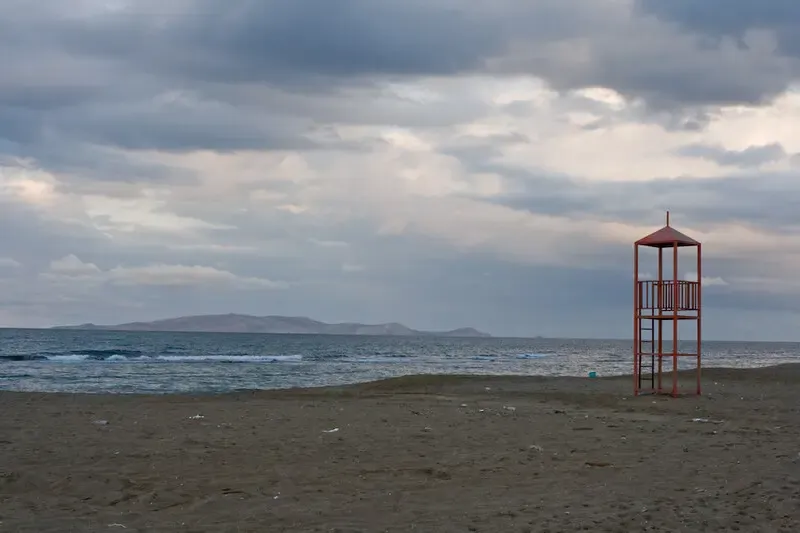
During the Classical and Hellenistic periods, the shoreline was linked to the ancient city of Knossos’ port at Katsambas, a harbor that handled trade with mainland Greece, Egypt, and the Aegean islands. Excavations near the Amoudara–Heraklion axis have revealed burial sites, ceramics, and coin hoards that date to these centuries.
In the Byzantine and Venetian eras, the coast west of Heraklion remained strategically important as it provided open landing grounds for ships approaching the fortified city, then known as Candia under Venetian rule (1205–1669). Ottoman records after the conquest in 1669 mention agricultural estates and water mills in the Amoudara plain, tied to grain cultivation for Heraklion.
Thus, while today Amoudara is recognized as an extensive beach zone, historically it functioned as the agricultural and maritime periphery of Knossos and later of Heraklion/Candia, linking Crete’s political centers with the northern sea routes.
11. Plakias Beach (South Crete)
Plakias lies on the southern coast of Crete along the Libyan Sea. Archaeological surveys in the region indicate human activity since the Minoan period (c. 2000–1450 BCE). The fertile Kourtaliotiko Gorge, which opens near Plakias, contained Minoan farmsteads and provided a natural route from the interior to the coast. Ceramic finds and tombs from the Late Minoan period have been documented in surrounding villages such as Sellia and Myrthios, suggesting that the wider bay of Plakias was integrated into the Minoan settlement network.
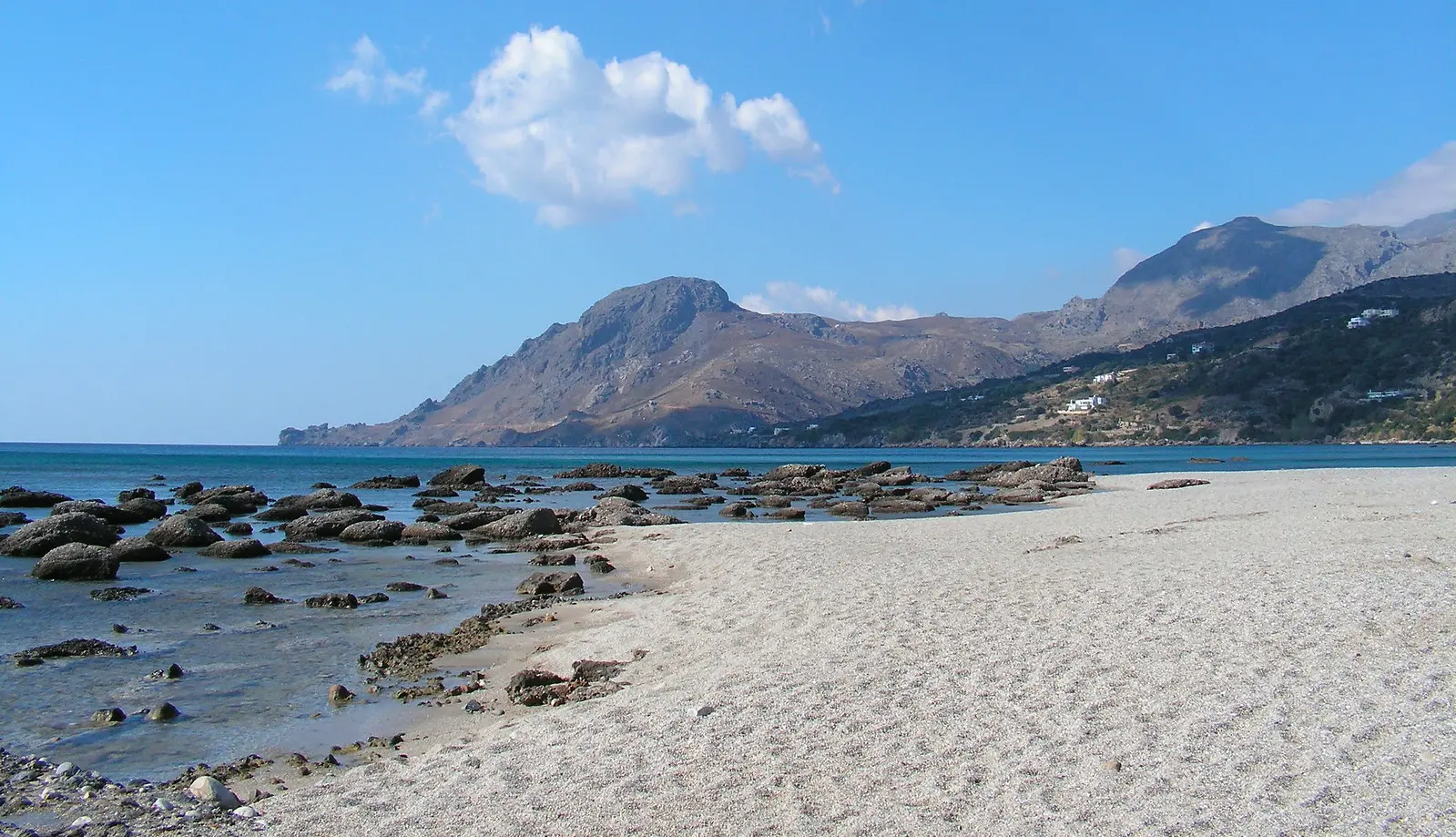
In antiquity, the nearest urban center was Phoenix (modern Loutro), a coastal port of the city of Anopolis mentioned by geographers like Strabo in the 1st century CE. The southern shore of Crete, including the Plakias area, formed part of maritime routes linking the Aegean with North Africa. Roman-era remains, including cisterns and rural villas, have been recorded within a few kilometers of the bay, showing that the coast was used for agriculture and local trade.
During the Venetian period (13th–17th centuries), southern Crete’s exposed shores, like Plakias, were vulnerable to pirate raids. Venetian documents describe coastal watchtowers and garrisons placed along the Libyan Sea to monitor movements. The lack of a sheltered harbor meant Plakias remained a small fishing site until the late 19th century, preserving its archaeological and historical traces in relative isolation.
12. Matala Beach
Matala, on the southern coast of Crete, has been inhabited since antiquity and is one of the island’s most archaeologically significant coastal sites. The cliffs above the beach contain numerous rock-cut caves, some natural and some enlarged by human activity, which were used as Roman and early Christian tombs between the 1st and 7th centuries CE. Inscriptions and structural modifications confirm their function as burial chambers during the Roman occupation of Crete, when Matala served as the port of Phaistos, one of the major Minoan palatial centers.
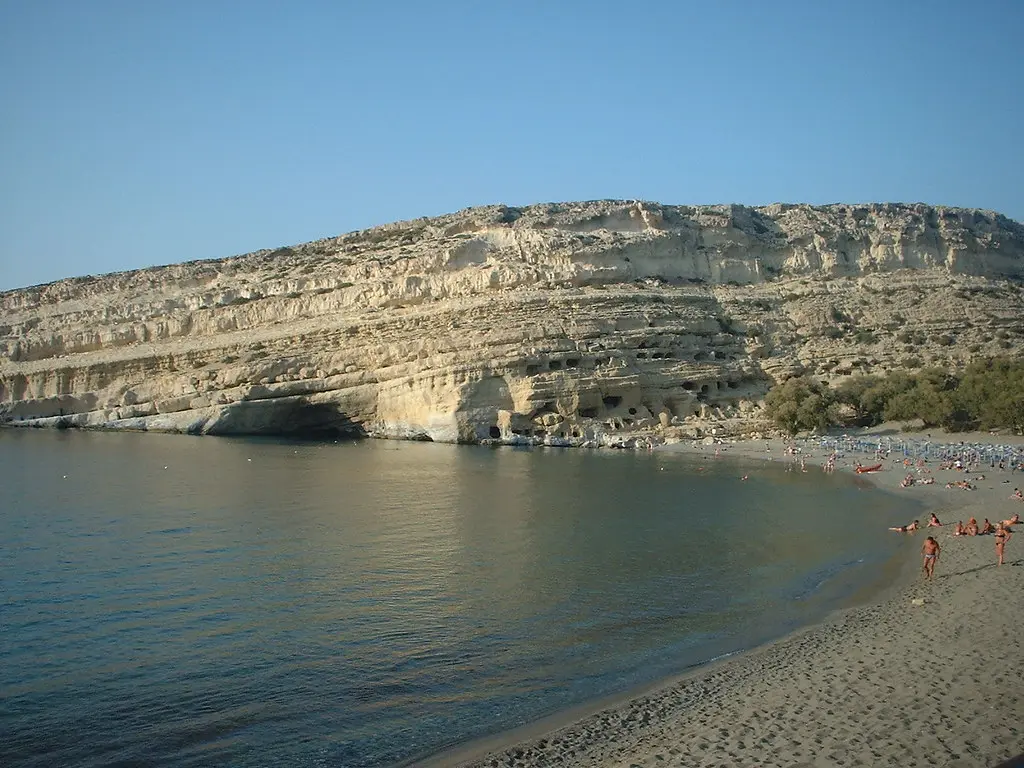
References in ancient sources, including Pausanias and later geographers, describe Matala as the harbor of Phaistos and later of Gortyn after Phaistos declined in importance. The protected bay provided an ideal anchorage for ships crossing the Libyan Sea toward North Africa. Excavations in the area have uncovered Roman warehouses and remnants of harbor installations, further confirming its commercial role.
During the Byzantine and Venetian periods, the caves were occasionally reused for habitation and storage, though the harbor lost prominence after Gortyn was destroyed by Arab raiders in the 9th century. The continuity of human presence — from Minoan seafarers to Roman traders and early Christians — makes Matala Beach not only a natural landmark but also a site that encapsulates the shifting maritime history of southern Crete.
13. Hersonissos Beaches
The modern resort area of Hersonissos occupies the site of ancient Chersonesos, one of the key harbor towns of northern Crete. Archaeological evidence shows that the settlement flourished from the Hellenistic period (4th–1st century BCE) through the Roman and early Byzantine periods (1st–7th century CE). Chersonesos functioned as the main port of Lyttos, a powerful inland city-state, providing maritime access for its agricultural exports such as olive oil and wine.
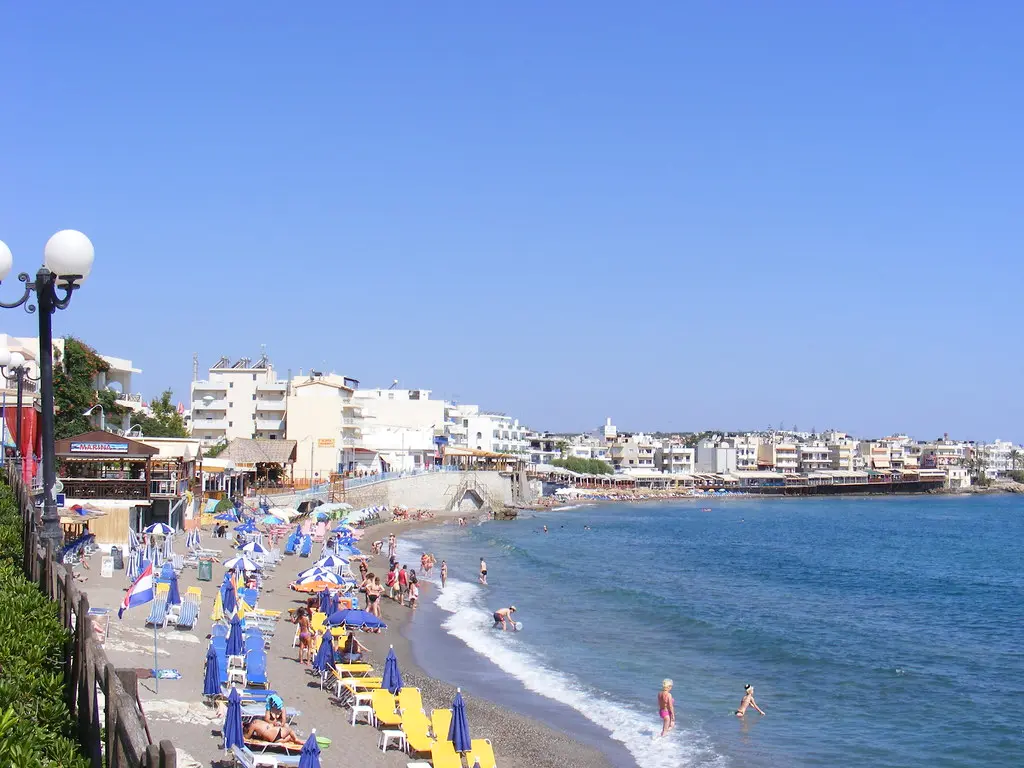
Excavations have revealed extensive remains along the shoreline, including Roman harbor installations, mosaics, baths, basilicas, and cemeteries. Notable discoveries include a 3rd-century CE mosaic depicting marine life and several early Christian basilicas with intricate floor designs, indicating that Chersonesos was both a trading hub and a religious center.
The city declined after the Arab conquest of Crete in 824 CE, when many coastal towns were abandoned or fortified against raids. During the Venetian period (13th–17th centuries), the bay of Hersonissos was still used as a secondary anchorage, though without the prominence of earlier centuries. Place-name continuity from “Chersonesos” to “Hersonissos” preserves the link with its ancient maritime role.
Thus, the beaches of Hersonissos are situated directly on the remains of a port that once connected inland Crete to trade routes stretching across the Aegean and the wider Mediterranean.
Conclusion
The beaches of Crete are more than places of natural beauty; they are landscapes layered with history. Elafonissi recalls episodes from the Greek War of Independence, while Balos is bound to Venetian fortifications and pirate legends. Falassarna preserves the ruins of an ancient city-state destroyed by Rome, and Vai shelters Europe’s only native palm forest mentioned by Theophrastus. Kitroplatia reflects the growth of Agios Nikolaos from Minoan tombs to Venetian harbors, while Nea Chora illustrates Chania’s expansion beyond its fortified walls, rooted in the ancient city of Kydonia. Rethymno’s shoreline was tied to coin-minting Rithymna and later fortified by the Venetians, and Elounda connects directly to submerged Olous and the fortress of Spinalonga.
Further east, Malia Beach lies near one of Crete’s major Minoan palaces, while Amoudara was part of Knossos’ agricultural hinterland and Heraklion’s Venetian periphery. Plakias marks ancient routes from the interior to the Libyan Sea, and Matala served as the harbor of Phaistos and later Gortyn, its caves adapted as Roman tombs. Finally, Hersonissos stands on the site of Chersonesos, the port of Lyttos, and a flourishing Roman-Byzantine town.
Together, these beaches form a continuous thread: each cove and bay is not only a site of leisure but also a witness to Crete’s role as a crossroads of civilizations, trade, and cultural exchange across millennia.
FAQ
1. Which beaches in Crete are best for combining sunbathing and exploring local shops and eateries?
Elounda, Rethymno Beach, and Agia Marina are top choices — offering golden sands, calm waters, and easy access to seaside boutiques, tavernas, and markets.
2. Are there beaches in Crete with nearby traditional markets?
Yes, Rethymno and Chania’s Nea Chora Beach are excellent for visitors who want to browse traditional markets just steps from the sea.
3. What’s the best area in Crete for a beach day with local shopping nearby?
Chania’s coastline blends relaxed beaches with charming old-town shops, artisan stores, and local eateries within walking distance.
4. Are Crete’s shopping beaches family-friendly?
Absolutely — beaches like Agia Marina and Bali Beach offer gentle waves, sunbeds, and nearby cafes ideal for families.
5. Can I find handmade products near Crete’s main beaches?
Yes, many coastal towns — especially Rethymno and Elounda — have boutique shops selling handmade jewelry, leather goods, and local olive oil products.
6. When is the best time to visit Crete for beach relaxation and shopping?
Late May to early October offers the best weather, warm seas, and open local shops without the heavy crowds of peak summer.


